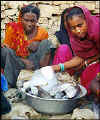| the-south-asian.com SEPTEMBER 2001 | ||
| about us contact us data bank past issues the craft shop the print gallery | ||
|
SEPTEMBER 2001 Contents Interview Heritage Cultural Heritage of south Asia People Communities Lifestyle Films Editor's Note
Books
|
Page 2 of 3
The African Diaspora of
the Indian Sub-continent by Zachariah Cherian
Mampilly
Indo-Africans trace their ancestry primarily from the East African coast from Sudan, Abyssinia (now Ethiopia) to Mozambique, but some came from as far off as South Africa and even Nigeria. Little research has been done on this unique population, but slowly literature on this small group is growing. Many of the Indo-Africans who arrived from eastern Africa came as sailors and traders engaged in the vibrant Indian ocean trade and stayed on in India, usually around the main ports, from Kerala in the south to Gujarat in the north. The monsoon winds that blew across the Indian ocean powered an extensive trade system that shipped spices from Kerala through Northeast Africa and on to Rome and other parts of the European continent since before the time of Christ. Ivory, gold and other valuables from Zimbabwe and the Congo found their way to the East African coast to areas such as Kilwa, Mombassa and Zanzibar from where they were further shipped across the Indian Ocean and on to India, Southeast Asia, China and even Japan. Perhaps the most interesting example of Indo-Africans in Indian history was the establishment of the Habshi State in Bengal during the 15th century. As the story goes, the ruler of the state was killed in a palace coup d'etat led by an Indo-African general serving in the king's army, who went on to proclaim himself king. He was subsequently killed by another high-ranking Indo-African general who remained loyal to the original ruling family and placed the young son of the murdered king upon the throne. Another group of Indo-Africans, known as the Shemali, originated in Kano, Nigeria, and came to India via Sudan and Mecca following their Hajj pilgrimage. Under the leadership of a wealthy merchant known as Baba Ghor, the Shemali became prosperous through the mining and trade of the precious stone Agate. This group of Indo-Africans retains quite a few African customs, and Baba Ghor and the story of their arrival in India is proudly remembered. It is difficult to speak of the Indo-Africans as a singular group as they came from vastly different parts of Africa and through many periods of history. Nonetheless, most of the groups have largely assimilated into Indian society. The majority of Indo-Africans are Muslims, but other similarities are hard to find. Different communities speak different languages and culturally most consider themselves Indian save for a few African cultural remnants. Some Indo-Africans, descended from powerful soldiers, administrators, and even rulers, are indistinguishable from the general population, for their ancestors were considered higher class and married freely amongst the elite Indian population. This group of Indo-Africans are sometimes known as the Royal Sidis, and they only marry amongst themselves or with upper class/caste native Muslims.
Copyright © 2000 - 2001 [the-south-asian.com]. Intellectual Property. All rights reserved. |
|


